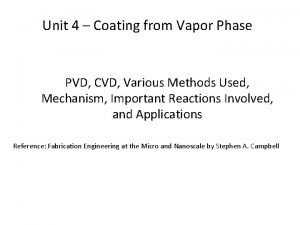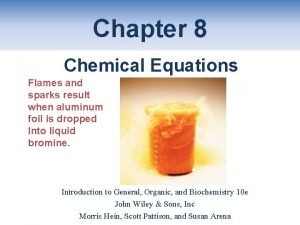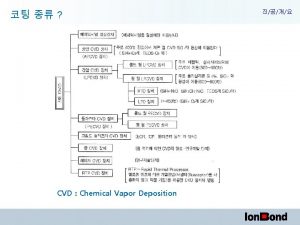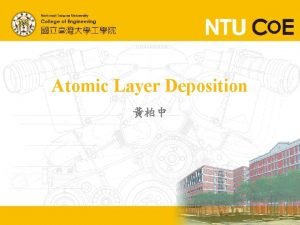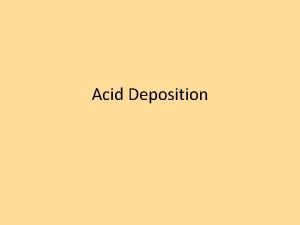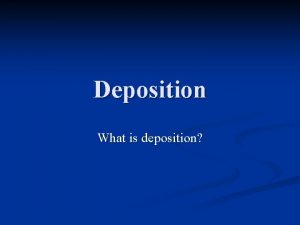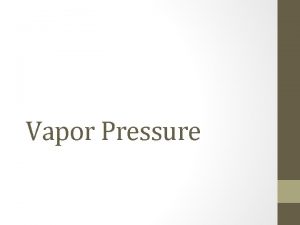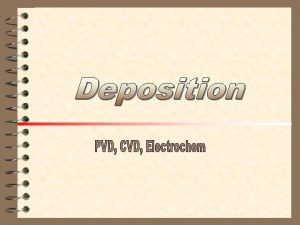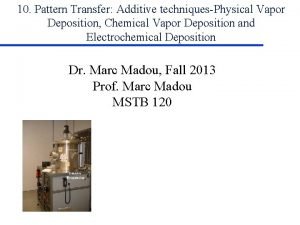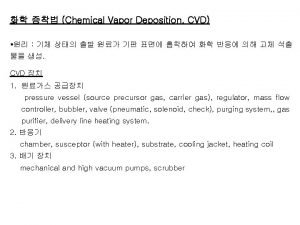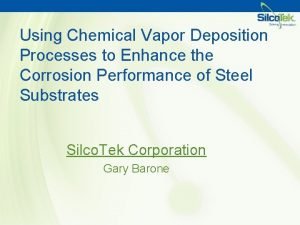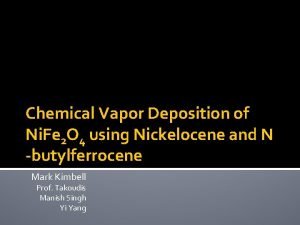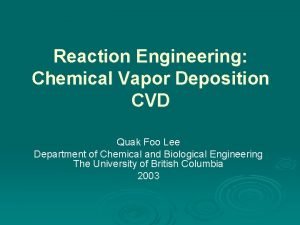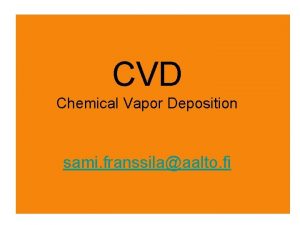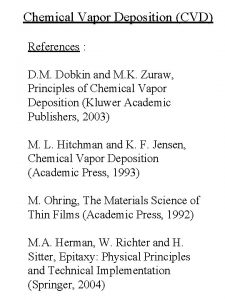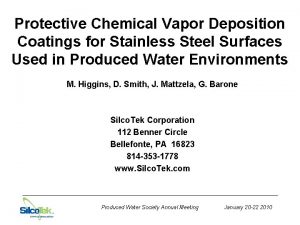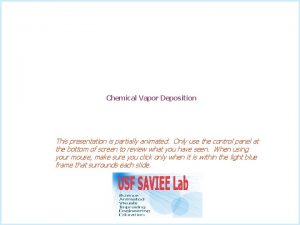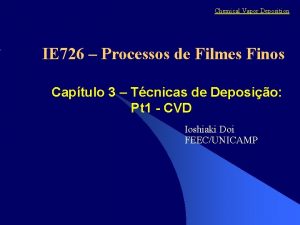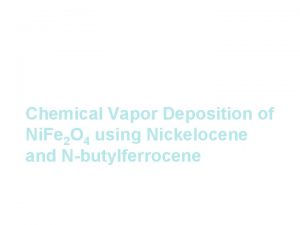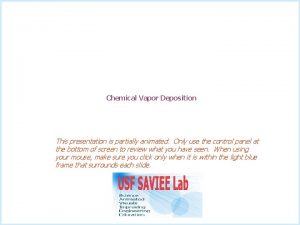Chemical Vapor Deposition Introduction The term Chemical Vapor





















- Slides: 21


Chemical Vapor Deposition

Introduction • The term, Chemical Vapor Deposition (CVD) generally applies to a process which “converts” some precursor gases, into a new material that is deposited on a substrate. • The chemical reactions that cause the “conversion” into a new material are driven by energy supplied by; – Temperature (simply called CVD). – Plasmas (called Plasma Enhanced Chemical Vapor Deposition, or PECVD). – Photons (usually called photo-chemical vapor deposition, or Photo-CVD). • CVD process of all three types are often done at low pressure, to obtain uniform deposition and better control of the chemical reaction.

LPCVD • Low Pressure Chemical Deposition (LPCVD) is a term applied to thermally driven CVD done at low pressures. • The combination of available chemistry, temperature, and substrate control the rate of deposition.

LPCVD • A widely used chemical vapor deposition tool that can be used for top down or bottom up processing. • Lower pressures are utilized to control reactions and film uniformity. • Heat is used to initiate and increase reaction rates, i. e. processes are activated (αe-∆/k. T).

Outline • Chemical Vapor Deposition • Typical LPCVD systems/hardware • Top down applications – 2 D materials (thin films, VS growth) • Bottom up applications – 1 D materials (nanowires, VLS growth)

Form and Function • LPCVD generally operates under medium vacuum (0. 1 ~ few Torr). • Medium vacuum increases the diffusivity of the reactant gas molecules. • Since the reaction is not limited by the availability of gases at the substrate’s surface, the chamber can be designed to optimize substrate capacity, and increase throughput. • Typically a recipe can take hours. This is not economically feasible for a single substrate, so batch processing occurs in most systems.

LPCVD Reactor • Hot wall reactors are favored because they provide uniform temperature over a large operating length. • Growth rate decreases further from the gas inlets. Increased temperature in the further regions of the tubes creates greater uniformity on the substrate. • The chemistry and heat are balanced to provide uniformity across the substrate and the batch.

Batch LPCVD Horizontal Reactor Pressure gauge Three zone heating element Insulation Quartz Tube (Chamber) Gas Flow Exhaust spent gas to pump Boat Internal (profile) Thermocouples Gas inlet External Thermocouples Public Domain: Image Generated by CNEU Staff for free use, 2009.

Batch LPCVD Vertical Reactor Insulation Boat Wafers Outer Quartz tube Inner Quartz Tube Heating Elements External Thermocouples Internal (profile) Thermocouples Exhaust spent gas to pump Pressure gauge Gas Inlet Public Domain: Image Generated by CNEU Staff for free use, 2009.

Horizontal vs Vertical Reactors • Vertical reactors tend to have less particulate problems. • It is more difficult ($) to control temperature in a vertical configuration.

Typical LPCVD Public Domain: Image Generated by CNEU Staff for free use, 2009.

LPCVD • The system shown on the last slide is a typical horizontal hot wall batch processing furnace, with three temperature zones and quartz reactor tube. • Substrates are closely packed vertically. • Instead of diluted gases, low pressures are used to control gas phase nucleation. – 0. 1 ~ few Torr. – Does not have an automatic loader (cost reducing). • The design is very similar to the conventional process furnace. The furnace can be configured for atmospheric oxidation, and annealing with inert or reactive gas.

Typical Gas Scrubber • Delatech 857 Controlled Decomposition / Oxidation System (Gas Burner) Scrubber – Known as a CDO (Controlled Decomposition/Oxidation Unit). – Uses a two stage process in which the exhaust is first oxidized at high temperatures (around 850 o. C). – Scrubbed with water to remove particulates and mineral acids. This type of system requires a waste water stream of about two gallons per minute.

Automate Low Pressure Chemical Vapor Deposition Automate Low Pressure CVD System How It Works: A gas or vapor precursor is transformed into solids such as thin films, powders, or various structured materials inside a reactor. Temperature and pressure are controlled to tailor the deposition results. Material / Applications: Chemical vapor deposition (CVD) is a versatile technique often used in the semiconductor industry for deposition of material on various substrates such as silicon nitride. It has also been used to produce carbon fibers, filaments, and tubular carbon materials for many years. Recently, CVD has been used to synthesize a variety of nanostructured materials, including carbon nanotubes and nanowires composed of various materials. Hydride Gases Diborane, Phosphine, Silane Other Gases Nitrogen, Hydrogen, Argon, Methane, Ethylene Tube Dimensions 25 mm diameter x 200 mm single zone reaction chamber Vacuum Base Pressure 20 m. Torr Pump Description Rotary Vacuum Pump ~cost $120, 000 tool only. A complete system price is approximately double this. Public Domain: Image Generated by CNEU Staff for free use, 2009.

Automate LPCVD Public Domain: Image Generated by CNEU Staff for free use, 2009.

Screen Capture of the Automate LPCVD Control Screen Public Domain: Image Generated by CNEU Staff for free use, 2009.

Gas Detection LPCVD • • Air samplers Hydride reactive tape Audible and visual alarms Readings continuously taken/stored. Public Domain: Image Generated by CNEU Staff for free use, 2009.

Gas Detection for a Typical LPCVD Side view of tape and detection system Pressure Transducer Port Air Sample Outlet Chemical Tape Top view of tape LED Light Source Air Sample Inlet Photodetector 4 3 2 1 Public Domain: Image Generated by CNEU Staff for free use, 2009. Electronics

Gas Detection for LPCVD • There are six air samplers connected to the monitoring tape placed throughout the gas delivery system, the tool, and the room. • When a hydride gas comes in contact with the monitoring tape, a chemical reaction takes place changing the optical properties of the tape in the position corresponding to the air sampler where the leak is occurring. • A sensor recognizes the change in the optical properties of the tape and triggers the audible and visible alarms. • The systems saves the concentration and type of gas, as well as its position on the tape, in memory until it is cleared. • Currently the system is set up to recognize a concentration of 1 ppb of hydride gas. • Each Unit is ~$15, 000 with an annual maintenance contract of $5, 000/year (2008). • Each tape cassette is replaced every 3 months at a cost of ~$1, 600/year (4 test points).

Gas Scrubber for Small Volume LPCVD The scrubber is intended for the conversion of hydride materials from the incoming gas stream into non-hazardous materials. Scrubbers can be designed for any other specific chemistry. Each scrubber canister is ~$8, 500/year to maintain Nova. Safe webpage Nova. Safe Product Info Atomate Scrubber System Operator Manual. Atomate Corporation. 2006
 Vapor saturado e vapor superaquecido
Vapor saturado e vapor superaquecido Chemical vapour deposition
Chemical vapour deposition Wiley
Wiley Long term plan and short term plan
Long term plan and short term plan In my understanding
In my understanding Long term memory vs short term memory
Long term memory vs short term memory How to find the nth term of a sequence
How to find the nth term of a sequence Example of short term human resources
Example of short term human resources Term-to-term rule
Term-to-term rule Difference between long term and short term liabilities
Difference between long term and short term liabilities Long-term liabilities examples
Long-term liabilities examples Minterm and maxterm
Minterm and maxterm Nth term rule
Nth term rule Term to term rule
Term to term rule Short term goals examples
Short term goals examples Research paper on financial planning and forecasting
Research paper on financial planning and forecasting Hình ảnh bộ gõ cơ thể búng tay
Hình ảnh bộ gõ cơ thể búng tay Frameset trong html5
Frameset trong html5 Bổ thể
Bổ thể Tỉ lệ cơ thể trẻ em
Tỉ lệ cơ thể trẻ em Voi kéo gỗ như thế nào
Voi kéo gỗ như thế nào Chụp tư thế worms-breton
Chụp tư thế worms-breton

